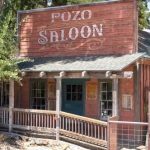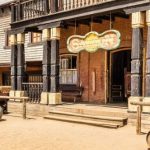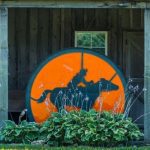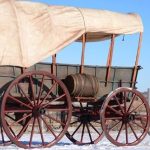 Technology
Technology  Technology
Technology  Humans
Humans 10 Everyday Human Behaviors That Are Actually Survival Instincts
 Animals
Animals 10 Animals That Humiliated and Harmed Historical Leaders
 History
History 10 Most Influential Protests in Modern History
 Creepy
Creepy 10 More Representations of Death from Myth, Legend, and Folktale
 Technology
Technology 10 Scientific Breakthroughs of 2025 That’ll Change Everything
 Our World
Our World 10 Ways Icelandic Culture Makes Other Countries Look Boring
 Misconceptions
Misconceptions 10 Common Misconceptions About the Victorian Era
 Mysteries
Mysteries 10 Strange Unexplained Mysteries of 2025
 Miscellaneous
Miscellaneous 10 of History’s Most Bell-Ringing Finishing Moves
 Technology
Technology Top 10 Everyday Tech Buzzwords That Hide a Darker Past
 Humans
Humans 10 Everyday Human Behaviors That Are Actually Survival Instincts
 Animals
Animals 10 Animals That Humiliated and Harmed Historical Leaders
Who's Behind Listverse?

Jamie Frater
Head Editor
Jamie founded Listverse due to an insatiable desire to share fascinating, obscure, and bizarre facts. He has been a guest speaker on numerous national radio and television stations and is a five time published author.
More About Us History
History 10 Most Influential Protests in Modern History
 Creepy
Creepy 10 More Representations of Death from Myth, Legend, and Folktale
 Technology
Technology 10 Scientific Breakthroughs of 2025 That’ll Change Everything
 Our World
Our World 10 Ways Icelandic Culture Makes Other Countries Look Boring
 Misconceptions
Misconceptions 10 Common Misconceptions About the Victorian Era
 Mysteries
Mysteries 10 Strange Unexplained Mysteries of 2025
 Miscellaneous
Miscellaneous 10 of History’s Most Bell-Ringing Finishing Moves
10 Ways Childhood Really Sucked in the Old West
When one thinks of the Wild West, visions of rugged cowboys galloping across barren landscapes and chaotic saloon brawls come to mind. Who doesn’t imagine a shootout or maybe a cattle-roping adventure? However, it’s important to note that reality often differs from the romanticized portrayal of this era in popular culture.
As it really was, the West was not quite as lawless as commonly believed. Life there was still very, very hard, though. The pioneers who inhabited the vast American frontier during the 19th century certainly faced their fair share of problems. And children usually got it the worst. After all, the Wild West was not just a place for adults but also a home to many children.
From indigenous American tribes to pioneering families, the presence of children was ubiquitous on the frontier. But what was it truly like for these young ones to come of age in that era? Did they constantly find themselves in dangerous situations? How did they spend their free time? Reality may be different than you imagine. Today, these ten facts will help you dive deep into the untold story of childhood in the Old West.
Related: Twelve Ways People Spent Their Free Time in the Old West
10 Get Ready to Work HARD!
Cooperation and hard work were paramount for the pioneering families that established themselves out West and those still traveling that way. Even the youngest members of the family were expected to contribute. And the tasks assigned to them might seem daunting to modern children.
At the time, many young children were ordered to care for livestock, milk cows, tend the garden, and gather firewood before sunrise. Girls were not exempt from these duties and were often seen performing the same tasks as their young brothers.
However, the work assigned to children was not on par with that of adults. Parents and caregivers were mindful of the limitations of youth. Thus, certain tasks were off-limits. For example, expecting a child to handle the hazards of wrangling a large steer would be unrealistic. However, when children were able to assist with more demanding duties, they often reported a sense of accomplishment and pride in their contributions to the family’s survival.
Take Edna Matthews, a young girl from the West who recalled her life there years later. She fondly remembered how her mother and siblings managed the farm during her father’s absence as a soldier in the Civil War. It was brutally hard work for Edna and many other children then. But it also gave them a sense of purpose and taught them work ethic. Plus, it allowed them to live relatively happily on their homestead.[1]
9 Stay Close to Mom for Protection
As settlers from back east ventured into the western frontier, they began claiming land and building homes. Of course, these lands had been inhabited for thousands of years by indigenous tribes. The Sioux, Arapaho, Cheyenne, Kiowa, and hundreds of others had already laid claim. Many of those Great Plains tribes had a nomadic way of life, while Pueblo tribes such as the Zuni and Hopi were more settled. The arrival of eastern settlers and the imposition of restrictions led to conflicts for native families.
Ultimately, the Indian Wars and the establishment of reservations altered life forever for these groups. And among the most affected were children. For centuries in these communities, children were cherished and mentored by a wide circle of community members, not just their immediate family. Indigenous communities were raised children in certain ways for generations. Ancestors handed down child-rearing techniques and parenthood styles. Suddenly, with the arrival of white settlers, these customs changed.
Within the indigenous tribes of the Great Plains, young children were often kept close to their mothers during the early years of their life. They were carried in a cradleboard strapped to their mother’s back. As boys grew older, they would often receive new names. With many tribes, girls were less likely to be renamed. With the Blackfeet, for example, some young members were designated as the tribe’s “favored child.” They usually came from a prominent family and were pampered, showered with gifts, and groomed for leadership roles.
Across many tribes, American Indian children were expected to work and take on adult responsibilities as they grew older. That included learning about their particular and expected social roles. However, physical punishment was not commonly used as a method of discipline. It looked different from how settlers raised their kids. Still, the amount of oversight and discipline in native communities was significant.[2]
8 Pack Up, Move Out, Repeat Endlessly
For the offspring of every ethnicity in the untamed frontier, relocating to a new home was a regular task. This was especially true for multiple generations of indigenous children. Many tribes frequently traversed the Great Plains each year. Indigenous communities would migrate for trading, hunting, finding sustenance, and fostering relationships with allied tribes.
Youngsters belonging to tribes such as the Cheyenne, Osage, and Sioux were expected to assist in the process of shifting camp. Similarly, children from settler families venturing westward were expected to fulfill all their daily duties while on the road. That was required despite the rough journey and sometimes brutal conditions on the trail.
Some young ones embraced this incessant migration. A few children even relished in the thrill of it! But most found the experience to be scary and full of uncertainty. A portion of that dread was instilled by the knowledge that the surroundings could be lethal. As is the case today, children then were plagued by uncertainty. Lacking a regular schedule while moving, they struggled to figure out the reason behind their family’s departure from the only home they had ever known.
That there were many dangers on the vast and featureless prairies only made things that much worse. The journey posed great terrors for some young travelers—but their parents didn’t have the time, resources, or knowledge to coddle them. They just had to get moving and keep at it until they got to their homestead.[3]
7 School Was an Ordeal
In the rugged landscape of the Wild West, life and parenting were vastly distinct from what we know today. However, one aspect that remained constant was the importance of education. Settlements strived to establish a school, regardless of its size, to prove their civility and progress. One-room schoolhouses were a common sight. After all, it was more practical for students to travel a shorter distance to a small school rather than a longer trip to a larger one. In that way, the children of the Wild West had the opportunity to learn and grow academically under the guidance of a schoolteacher. But still, it was not an easy task to establish such an institution on the untamed frontier.
In that era, schoolteachers were tasked with the monumental responsibility of educating multiple grade levels. There just weren’t that many school staffers around in the Old West. In fact, there was typically only one teacher for the entire building!
The community was responsible for everything about the school. They worked upkeep and maintenance for the building itself, from constructing desks to ensuring the warmth of the wood-burning stove. The settlement also usually provided housing and meals for the teacher. However, access to education was not equal for all.
Non-white kids were often denied the opportunity to attend school due to discriminatory laws that deemed them inferior. To counter this, some ethnic communities—notably Chinese immigrants in California—established their own schools. On the other hand, the most underprivileged Hispanic families in the Southwest were only able to receive minimal education through the efforts of local Catholic missions.[4]
6 School Was Even Worse for Native Children
As the frontier expanded, native families were horrified to discover the oppressive educational system imposed upon them. Boarding schools were established for indigenous children. But they were not a benevolent endeavor. Instead, the boarding schools were a calculated effort to eradicate traditional tribal culture.
Native American children were forcibly enrolled, stripped of their original names, dressed in foreign attire, coerced to adopt Christianity, prevented from using their language, and told their heritage was inferior. Initially, schools were established on or near reservations. However, it quickly became apparent to white school leaders that this allowed for less assimilation. So the U.S. government began to fund boarding schools that separated children from their families.
One of the most notorious examples was the Carlisle Indian Industrial School. It opened in 1879 and served as a model for similar institutions in both the United States and Canada. The atrocities committed at this and other boarding schools left a lasting impact on the children forced to attend them.
Reports of verbal abuse and physical brutality were common among students. Disease was also a persistent problem. These overcrowded schools served as breeding grounds for illness. Many of the institutions even had dedicated burial grounds for their deceased students. Some students attempted to flee these institutions, but they’d get hunted down with the aid of bounties offered by schoolmasters.
Despite a federal law mandating attendance for Native American children in 1891, many families resisted the boarding schools. It wasn’t until several decades later, in the 1970s, that most of these institutions were finally shuttered.[5]
5 And the Future Only Got More Complicated
The American frontier was a place of surprising diversity in some ways. It attracted people from various backgrounds looking for economic opportunity and to start families. But despite the melting pot of cultures present in these western towns, deep-seated racist ideologies persisted. They made the lives of mixed-race and native children extremely tumultuous.
The societal upheaval following the Civil War further exacerbated this. After the 1860s, many Southerners were displaced and forced to establish new families while still holding on to remnants of their old ones. They pushed west, in turn putting pressure on Indian families.
Before the Civil War, mixed-heritage relationships in America were viewed with a certain degree of tolerance. However, the advent of anti-miscegenation laws came with a major societal shift post-war. Suddenly, these unions and the offspring resulting from them became increasingly stigmatized. Many fathers, particularly white ones, chose to abandon their non-white families. This left so-called “half-breed” children to suffer from ostracization from both communities.
These social pressures were unfortunately prevalent in the Old West. Men could strike further westward for new opportunities and leave behind a life they no longer wanted. There was a certain privilege and social standing for some mixed-heritage individuals with prominent parents, but that was very rare. The majority of native and mixed children were not as fortunate and had to endure a tough life.[6]
4 Do Whatever You Can To Help the Family
In the rugged Old West, the harsh realities of frontier life often overshadowed traditional societal norms. Isolated men were forced to embrace duties typically assigned to women. That included preparing meals and tending to domestic hygiene. Similarly, women were compelled to engage in labor traditionally reserved for men.
For adults and children alike, this meant eschewing gender norms and doing whatever they could to survive. Those demands extended to children, too. Interestingly, this allowed children some flexibility in the interests they took and the skills they learned. Girls weren’t required to be exclusively “girly,” as it were. They were encouraged to learn “male” coded skills to help the family in homestead settings.
Children in the West often grew up with a unique perspective on gender compared to those in the East. Settlers sometimes posed as members of the opposite sex to safeguard themselves in a harsh society. Women, in particular, were able to lean in on their more masculine traits without their neighbors thinking too much of it. After all, it was necessary to be tough to get by in the Wild West.
This fluidity in gender roles extended to children as well. The harsh conditions of frontier life necessitated that tasks be completed regardless of one’s gender. So children of both sexes engaged in activities that were not traditionally associated with their gender. In these communities, the lines between gender-specific duties were blurred. But it didn’t last long.
As the West was “won,” as it were, and civilization encroached enough for the region to lose its untamed essence, those blurred gender roles reverted back to their conventional distinctions. Kids were no longer needed to learn multiple tasks indoors and out. Life went right back to the way it was in the rest of America.[7]
3 Forget about Playtime
Across the Old West, life could be grueling and demanding. That was especially true for young ones saddled with difficult domestic duties. But there did still exist a sense of childhood innocence among settler kids… sort of. Though resources were scarce and luxuries were few, children were still seen as carefree beings deserving of playtime. Unlike in modern times, no sprawling toy stores were filled with flashy, electronic gizmos.
Instead, playthings had to be crafted from the limited materials available. Those toys often came at a premium for pioneer families living on tight budgets. Children would usually use everyday items such as wheelbarrows and sheets to create their own entertainment. The spirit of imagination was abundant, though. Social gatherings such as cheese-making parties were organized to add a touch of fun to the daily routine. It wasn’t much, but it was something.
Children of the frontier’s indigenous tribes also had ample opportunities for play. Some used simple things like strings to craft intricate designs akin to modern-day versions of the cat’s cradle. Other games and toys helped sharpen hand-eye coordination. One particularly popular game was a dart and target game that challenged kids to pass the dart through a rolling hoop.
Playtime was also a time for resourcefulness. Lakota children famously fashioned small replica horses from spare animal bones, spending hours crafting intricate and fascinating little toys for themselves. General stores on the plains were few and far between, of course. So why wait weeks or months to buy a toy when you could make it at home? A little ingenuity went a long way out West![8]
2 Death Was Always Right around the Corner
Death was a constant companion for frontier settlers. But for many, the dangers that threatened the lives of their loved ones were not always predictable. While some feared attacks from Native Americans, most tribes were peaceful. Wild animal attacks were rare, too; most avoided human contact. And despite the tragic fate of groups like the Donner Party, most pioneers could provide adequate sustenance for their families.
The true peril that loomed over the frontier was the ever-present threat of disease. A single sip of contaminated water could prove fatal for a young person miles away from the nearest doctor. More than gunslingers or snakes, it was the unseen microscopic invaders that posed the greatest danger to life in the Wild West.
In the harsh conditions of the Old West, the young and fragile were particularly susceptible to the ravages of malnutrition, fever, and dehydration. The abundance of illness and the scarcity of clean water resulted in an alarmingly high infant mortality rate. During the 1870s, every fifth child would not live to see their first year of life. Even more heartbreaking, due to the widespread rural population and the lack of medical professionals and record keepers, the actual number of infant deaths may be far higher.
But even after the first year, children had it rough. Disease could wreak havoc on a young immune system. Small children and teenagers routinely died from illnesses considered mild today. Such was the reality of life in the unforgiving Wild West.[9]
1 The Forgotten Plight of Asian Children
As we’ve noted, the Wild West was a melting pot of diverse cultures and ethnicities. African Americans, Latinos, and Asian Americans were all integral parts of the western frontier. Heck, the term “cowboy” itself stems from the Southwestern “vaquero” tradition. But despite their contributions, these communities faced rampant discrimination and racism.
The arrival of Chinese migrants in the late 19th century, particularly in industries like mining and rail construction, sparked a wave of anti-Chinese sentiment across the West. It ultimately led to the passage of the discriminatory Chinese Exclusion Act of 1882. That act severely restricted Chinese immigration to the United States.
Gaining entry into the U.S. was a rigorous task for Asian immigrants. In that era, even children were subject to intense scrutiny. Those who failed to pass evaluation at the border were denied entry. But getting into the country was only the beginning of the battle. Life was rough for those who did manage to settle in the West. Many Asian American children were caught between two worlds.
At home, they were pressured to hold on to their heritage. But locals who weren’t always so patient pushed them to assimilate to American society. The result left them feeling isolated and disconnected from both cultures. This struggle was compounded by the open discrimination many faced.
In much of the West, Asian immigrants were barred from certain businesses due to their ethnicity. Kids brought up in that environment internalized the hatred and discrimination. It made their emotional lives that much tougher on top of an already difficult childhood.[10]
+ BONUS: When It Was Over, It Was Over
The impermanence of youth is a fundamental aspect of childhood. But the notion of a transitional phase we call adolescence was foreign to those in the Wild West. The term “teenager” did not exist until the 20th century. Yet many communities in the Old West acknowledged the shift from childhood to adulthood through ceremonial rites and customs.
In contrast to modern society, children in the frontier were expected to mature much more quickly. These milestones were sometimes commemorated through traditional practices, such as a bar mitzvah for Jewish children—who were a rarity in the Old West. Today, the Latino culture recognizes a coming-of-age celebration known as quincenañera. It has its origins in Aztec customs. It was occasionally part of Western lore, too. However, the contemporary version of this celebration is more rooted in the 1930s.
As American Indian children approached puberty, they tended to spend more time with adults of the same gender. In doing so, they followed traditional gender-specific roles and activities. Certain tribes encouraged their teens to embrace adulthood by embarking on spiritual quests. Often, they included traveling, abstaining from food, and participating in spiritual ceremonies. Once the journey was completed, the child was considered an adult and prepared to start a new phase of life. And thus, childhood was over forever![11]








